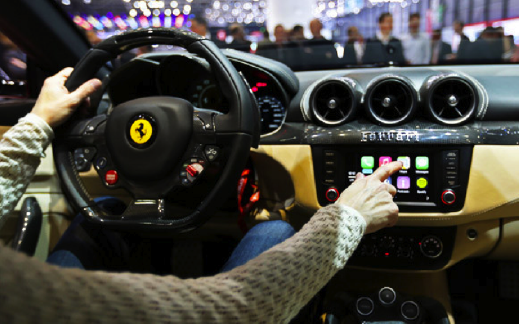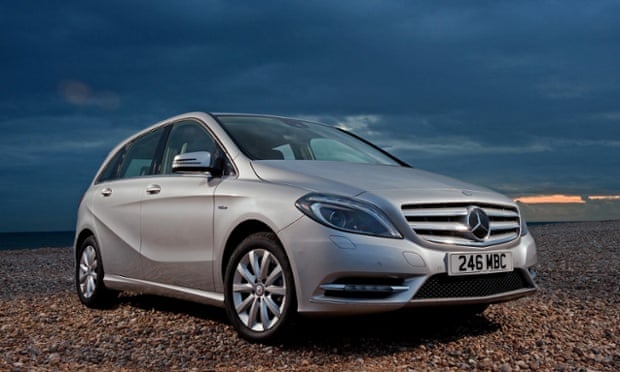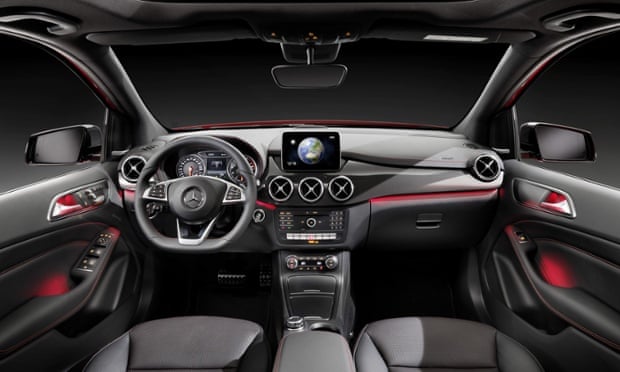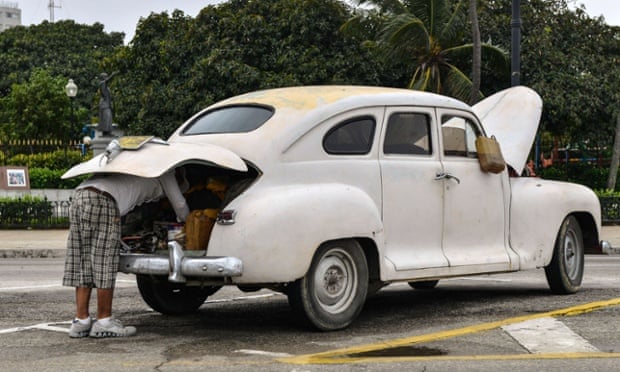On the road: Skoda Yeti Black Edition – <b>car review</b> | Technology <b>...</b> |
- On the road: Skoda Yeti Black Edition – <b>car review</b> | Technology <b>...</b>
- Apple's Real <b>Car</b> Play | MIT Technology <b>Review</b>
- Mercedes-Benz B-Class: <b>car review</b> | Technology | The Guardian
- 2015 Tesla Model S P85D <b>review</b> | Autocar
- <b>Car reviews</b> | First drives | Expert road tests by CAR Magazine
| On the road: Skoda Yeti Black Edition – <b>car review</b> | Technology <b>...</b> Posted: 27 Feb 2015 10:00 PM PST 'A bit of an eyesore for an urban vegetarian, but for the people who need what they're packing, irreplaceable.' Photograph: Simon Stuart-Miller for the Guardian The Skoda Yeti Black Edition is outlandishly ugly; it looks like a foreshortened hearse, and yet, despite the satisfyingly easy fold-down mechanism of the back seats, you could never fit a coffin in it. It's like a Nietzschean embodiment of disutility. There is something about its bearing – the way it is imposing and businesslike, but utterly unglamorous – that gives it a bureaucratic air. I drove through chocolate-box Cotswolds towns, with endless names telling you what they are under and twixt, imagining myself part of a military convoy examining what was salvageable from a wrecked civilisation. The mash-up with VW (two decades old, would you credit it?) has delivered a cockpit that is very Golf, with extra twiddly bits. An innovation I particularly liked was a second satnav screen above the speedo. However, the driver's armrest is awkwardly close to the handbrake; a small but infuriating thing. And yet, and yet; subjected to some profoundly challenging driving conditions, it triumphed, and I decided I didn't care what it looked like, or where the armrest was. Wednesday was spent driving alongside a cyclist while someone else took photos of him on miles of country road, causing huge inconvenience to other cars. I needed more than agility, which this has in surprising amounts; I needed enough acceleration that meant, when I'd finished, I could disappear at a speed that said, simultaneously, "I'm sorry for the delay," and "Eat my shorts". That I got. Does turbo-diesel get better all the time, or do my prejudices simply recede? The 2L TDI engine soared past everything. The next night I got caught in a snowstorm, flakes luminous in the headlights, like driving into a Maw Cluster in Star Wars. This is when you notice the Yeti is a 4x4, with its great traction and solid, unperturbed manoeuvrability. I may have been the fastest vehicle on the M1 (not, I underline, by breaking the speed limit; just because everyone else was chicken). And the day after that, Ikea. The tribulations of that journey aren't so much in the driving as in the stopping and starting; this is when you notice your posture: how long would you be able to remain in the car before you felt as if your back were broken and your achilles tendons had snapped in sheer frustration? And the results, again, were difficult to fault. It's roomy in the front and the back, and the reach is well designed. I came round to this beast; it's like having a bison or something. A bit of an eyesore for an urban vegetarian, but for the people who need what they're packing, irreplaceable. Price from £23,990 (as tested, £24,515) • Follow Zoe on Twitter |
| Apple's Real <b>Car</b> Play | MIT Technology <b>Review</b> Posted: 27 Feb 2015 01:40 PM PST The world's most valuable company doesn't need to build a car in order to reinvent driving.  The Ferrari FF was the first car to include Apple's Car Play. It's been fascinating to read all the recent discussion and speculation over Apple's supposed car project—and to wonder if a company that already dominates several huge product categories thanks to innovative design and engineering might pull off the same trick with the automobile. I think most of the talk misses an important point, though. Apple may well intend to reinvent driving, but it hardly needs to build its own car to do that. Its ambitions are, I think, more likely focused on the software and interfaces found in vehicles—the code that shapes the driving experience, and increasingly makes vehicles actually run—than on developing the expertise needed to manufacture hardware such as chassis and brake lights. To some degree, Apple has already begun this journey with Car Play, software preinstalled in some new cars that transfers functionality from an iPhone to the vehicle's interior (see above). Apple, of course, has a remarkable record of inventing or reinventing hit products and taking over industries. But as the Economist points out, there are significant differences between the consumer electronics and automotive businesses. More important, replicating all the manufacturing carmakers already do isn't where the real opportunity lies. A smarter strategy, surely, would be to invest in developing new software, and maybe some new hardware, that transforms the driving experience, and then sell that technology to as many car manufacturers as possible. This is one area of the auto industry that does seem ripe for the Apple touch. The interfaces in cars are inconsistent at best, and often downright infuriating. The road that began with Car Play could gradually lead Apple to control more and more of the information, entertainment, and services found in cars. This would play to its considerable strengths in design, UX, and software/hardware integration while also helping lock people into its ecosystem—something that serves its existing hardware and software products nicely. The vehicle interface might seem like a small part of the auto picture, but appearances can be deceptive. As cars become more automated, the interface will play an important role, helping drivers manage automation and helping cars manage their drivers' attention (see "Proceed with Caution Toward the Self-Driving Car"). Apple might eventually reach further into the vehicle, offering software that monitors engine performance, power systems, sensors, and so forth. The company's rumored research on vehicle sensors and batteries would fit with such a plan. All this might seem like a distinctly Microsoft approach. But then, perhaps Apple envisions a future in which information, services, and entertainment are not served from any one product or device—but from a whole host of intelligent gadgets and appliances. In such a world, rewriting the code the runs inside cars would be more transformative than building one from scratch. |
| Mercedes-Benz B-Class: <b>car review</b> | Technology | The Guardian Posted: 28 Feb 2015 10:00 PM PST Attention seeker: the sleek lines of the new B-Class. What do Mercedes-Benz and my old history teacher Mr "Hefty" Heftner have in common? Quite a lot as it turns out. Both are German, both have a rich sense of heritage and both have evolved novel ways to keep you awake. One uses feedback from 70 sensors placed invisibly around you to produce auditory and visual stimuli to stop you dozing off, the other throws a chalk duster at your head. Both methods are extremely effective. You'll find it difficult to nod off at the wheel of a Merc, and we were all too terrified to fall asleep in O-level history. Mercedes has been at the forefront of safety innovation for decades. It put the crumple zone into production as long ago as 1951 and its anti-lock braking system (ABS) has been with us since 1970. Another industry first is Attention Assist. You don't have to be a genius to realise that falling asleep at the wheel is probably the fastest way to test your crumple zone, but that hasn't stopped the boffins from checking it. It's a research programme that can't have yielded many surprises – "Yes, Jürgen, it was just after you fell asleep that you crashed!" Indeed they found that between a quarter and a third of all motorway accidents are caused by driver fatigue. Amazing!  Come on in: the new Mercedes-Benz B-Class manages to be both compact and luxurious. Come on in: the new Mercedes-Benz B-Class manages to be both compact and luxurious. So this is where Attention Assist comes in. From the moment you start driving, your Mercedes keeps an eye on you. Using input from 70 sensors it creates a unique template of your driving style on that particular day. As your journey continues, it constantly monitors you to see how you are measuring up to that first impression. The heart of the system is the steering wheel. Tired drivers make dozens of tiny errors that they then correct immediately. If you start doing this, Attention Assist will check to make sure you are actually feeling sleepy by asking itself a series of questions: how long have you been at the wheel; are you listening to the radio; are you fiddling about with the car's controls; is the road pot-holed; are you being buffeted by a side wind? If the answer to these is not as expected, the system presumes you must be nodding off and the car emits an irritating beep and flashes a picture of a cup of coffee at you.  Inside story: the composed interior of the B-Class. Inside story: the composed interior of the B-Class. I tried it out in the new B-Class I was driving last week. I tried to fool the clever little car by starting out feeling totally knackered and thus creating a dodgy initial template. It saw through that and soon started beeping at me. Another time I pretended to drive like an exhausted person. Veering about, slamming on the brakes, nodding my head like a fat man at a Shakespeare matinee… The car saw through my wheeze and did nothing. More worryingly my wife didn't make any comment either. She said my driving had seemed no worse than usual. I didn't go as far as just closing my eyes… but even then a crash would have been tricky as the car's radar-controlled Collision Prevention Assist Plus equipment would have autonomously slammed on the brakes, while the Merc's Pre-Safe system would have tightened the front seat belts, adjusted the front head restraints and closed the windows and sunroof to ensure the best outcome from a smash. Safety gets a big tick in this small Benz. But then what did you expect from the upmarket B-Class? This latest update to the model also comes with sharper looks, more technology and a choice of engines: two petrol and four diesels. Handling is as precise as ever and the drive is calm, reassuring and soothing… No wonder they're worried you might drift off. New month, new car Is it time to trade in your old banger? Is it time to trade in your old banger? According to the website HonestJohn.co.uk, March could be your best month for buying a new car in years. A perfect combination of factors means it's certainly worth having a look, as low borrowing costs, low fuel costs and a boom in new models could result in a bargain for you. Research by Honest John shows that the typical APR for car finance has dropped by more than 3% over the past four years. At the same time, the number of high-street lenders offering finance deals has increased dramatically. The reason for this is that the price of borrowing is low – with the UK base rate of 0.5% finally filtering down to car buyers. March will also see many consumers buy new cars fuelled by the low cost of petrol. Compared to last year, a typical petrol hatchback owner will spend, on average, £200 less a year on fuel. Insurance costs are also at their lowest in years thanks to savings from an increase in car safety technology, eg autonomous emergency braking, and insurers clamping down on fraud. Finally Ford, Skoda and Volkswagen are all releasing their 2015 ranges this month. So, get yourself down to your local showroom and start the spring with a new set of wheels. Motorbike kit from Aldi Ready for the road: Aldi's new range of gear for bikers. Ready for the road: Aldi's new range of gear for bikers. Next time you pop into Aldi for your weekly groceries, you might also want to check out their new range of affordable gear for motorcyclists. As you would expect, the price is startlingly low, but what you might not have appreciated is just how good the kit is. Aldi's motorcycle jacket (£79.99) and trousers (£59.99) are both CE 2 certified, offering a high level of protection. On top of that there's a stylish neckwarmer (£2.99), thick socks (£3.59), gloves (£19.99) and boots (£29.99). All well worth a look, if you want your money to go further. For more details, go to Aldi special buy events. Email Martin at martin.love@observer.co.uk or follow him on Twitter @MartinLove166 Follow the Observer Magazine on Twitter @ObsMagazine |
| 2015 Tesla Model S P85D <b>review</b> | Autocar Posted: 26 Feb 2015 06:18 AM PST What is it?:The Tesla Model S has already wowed us in conventional form - if, indeed, the rear-wheel-drive, fully electric family hatchback could ever be called ordinary. Described in its full Autocar road test as "practical, refined and desirable - a triumph", the Model S has been available so far in a couple of guises: the regular 85, with 376bhp and a range of 310 miles, and the more modest 60, which has a smaller battery and a reduced range of 240 miles. The P85D is something else altogether. Instead of a single electric motor driving the rear wheels, it gets one on each axle to run in four-wheel drive - and the upgrades don't stop there. The rear-mounted motor gets Tesla's Performance designation (the 'P' in the model name), raising it to 464bhp, and with the front wheels offering an additional 218bhp, you suddenly end up with an entirely respectable-looking five or seven-seat family hatchback, with a combined output of 682bhp and 687lb ft. The resulting performance figures are pretty staggering. The top speed is a run-of-the-mill 155mph, but 0-60mph is claimed to take just 3.2sec. Let's think about that for a moment: that's the same time, to the tenth, as the official Autocar benchmark for the Ferrari 458 Speciale (the regular Italia is 0.1sec slower). It has the potential to make the P85D's list price of £79,080 look a bit of a bargain - especially when you consider that free access to Supercharging - Tesla's ever-expanding network of quick charging points - is included as standard. Nor should P85D users be any more susceptible to range anxiety than owners of more conventional Model S editions. Tesla claims that the car's digital power controls can utilise two motors more effectively than one - so there's actually a modest gain in range over the old rear-drive P85. It's now 300 miles, just 10 miles shy of the regular 85. Incidentally, the new model sits on top of a revised range, where the twin-motor four-wheel drive set-up (identified by the 'D' suffix) is also available as a £4100 upgrade to the regular 85. That edition gets a regular 50/50 power split between front and rear axles, though, with the same combined output as the 85. In the meantime, Tesla has quietly dropped the rear-drive P85 from the line-up; its reasoning is that anyone who wants the extra grunt will be happy to pay for the four-wheel-drive model that can make better use of it. What's it like?:To activate the P85D's full potential, you press a button on the huge central touchscreen marked (and I'm serious about this) 'Insane'. And that's pretty much how it feels. Tesla's acceleration test track was a well-abused mixture of greasy cold asphalt and coarse gravel, but the P85D still managed to deliver a level of acceleration that would be difficult for anything else to match in the same conditions. It's the initial punch that does it - the kind of uncompromising shove from 0-30mph that comes with the torque characteristics of electric motors in general, now mixed with four-wheel drive. What's missing, of course, is any sort of soundtrack. There's none of the sense of occasion that you get with a 458 attempting similar feats - or anything approaching the aural pleasure that can be delivered by a hard-worked AMG V8. Instead, you hear a distant whoosh as the twin motors kick in, accompanied by - and this is perhaps oddest of all - the sounds of the tyres themselves grabbing hold of the surface beneath them (on a dry road, presumably, you'll not even hear that). Once you're up and running, there's even less standing in the way of the P85D's colossal torque; you'll need to be well beyond the UK speed limit before you'd detect any discernible reduction in the car's ability to gain momentum. Try to carry too much speed into a corner and the P85D will simply understeer; behave yourself and the nose tucks in with more conviction than it does on the 85 (itself not a bad steer, by any measure). Regardless of how hard you're pushing, it stays admirably flat in corners - and there was enough compliance to dial out the worst road surface imperfections on Tesla's Norwegian test route. There's still not much communication, though; you get three weights of steering to play with, but despite this, and regardless of the P85D's ability to thrill and delight every time the traffic lights go green, this is not a car that makes you feel truly connected to what the tyres are doing. In that respect, at least, the P85D feels like one of the family - a slightly more planted and considerably quicker stablemate to the 85 and 60. The same can be said for refinement, really, because the large alloy wheels still create a fair amount of road roar once you're above 40mph. It's by no means noisy aboard the P85D, but nor is it as silent as you may expect a fully electric vehicle to be. The cabin remains a clever bit of packaging, with room for five adults and potentially two further children in rear-facing seats in the boot. The luggage capacity is still enormous, with space under the bonnet and in the traditional boot totalling almost 1800 litres. The finish on materials is of a remarkably high standard compared with any other American car - although a few elements are half a notch behind the best European executive models when you get to a close-up inspection. The showpiece of the cabin is still the Model S's gargantuan centre screen, a 17in behemoth of a touchscreen through which you control the majority of the vehicle functions, let alone infotainment or navigation. It's still a bit worrying to see the system redrawing chunks of map as it struggles to keep up with sheer amount of real estate it has at its disposal, and there are occasions when you'll wish they'd just fitted a permanent button - Volvo's new system on the XC90 does a better job of fast-tracking you to regularly used functions - but in the most part it's a triumph. Tesla has also rolled out the music streaming service Rdio to its cars via an over-the-air upgrade. In theory, the system allows you to press a steering wheel-mounted button and request any song - and voice recognition and a data connection will do the rest. In practice, you may find the search facility and data speeds more limiting than your own imagination. Should I buy one?:If you're in the market for a Model S - and we can think of plenty of reasons why you could be - then it's going to be hard to resist the all-round performance increase and all-weather ability of the P85D. It does feel noticeably quicker and a little more secure than a conventional 85, and the four-wheel drive means that it stands a chance of keeping you moving on those three days a year where the weather grinds Britain to a halt. You're paying a fair old premium, though; the four-wheel-drive 85D is still a car that can crack 0-60mph in just over five seconds, and there's a £14,000 hike from that car to the Ferrari-rivalling pace of the P85D. Even if you finance (the most appealing way into a Model S, realistically), you're looking at a premium of around £300 per month for a couple of seconds off the 0-60mph time. Many will look at the raw figures, do the maths and, with a tinge of regret, allow head to overrule heart. Those who don't will be picking one of the most remarkable production cars on sale today. Tesla Model S P85D Price £79,080 (after £5000 government grant) Engine Two electric motors Power 682bhp; Torque 687lb ft; Gearbox Single-speed, direct drive; Kerb weight 2238kg; Top speed 155mph; 0-60mph 3.2sec; Range 300 miles; CO2/tax band 0g/km/0% |
| <b>Car reviews</b> | First drives | Expert road tests by CAR Magazine Posted: 10 Feb 2015 12:00 AM PST Reviews from the expert road testers at CAR magazine in the UK. We test vehicles impartially and cover everything from sports and supercars to everyday hatchbacks and family estates. Use our search widget to find the car you're interested in |
| You are subscribed to email updates from car review - Google Blog Search To stop receiving these emails, you may unsubscribe now. | Email delivery powered by Google |
| Google Inc., 1600 Amphitheatre Parkway, Mountain View, CA 94043, United States | |
No comments:
Post a Comment